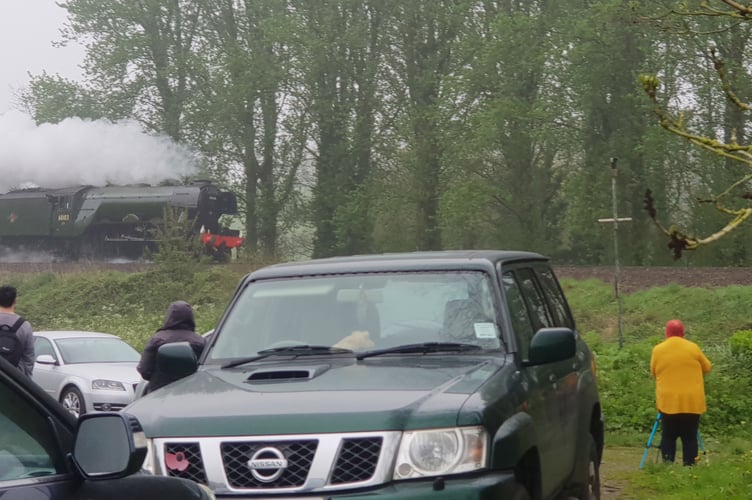HUNDREDS of train enthusiasts and others who were ‘just interested’ lined the main rail line through Wellington on Sunday (April 30) morning to catch sight of the world’s most famous steam locomotive.
The iconic Flying Scotsman steamed through as part of its centenary year tour of the UK, pulling nine carriages on a ‘Royal Duchy’ excursion from Bristol to Cornwall.
For many spectators it was a once in a lifetime experience to see and hear locomotive No 60103 in full steam, even though it proved to be much quieter than many had expected.

+ 13
(View All)
The Flying Scotsman in Sampford Arundel.
The Flying Scotsman arrived in Wellington on time as predicted by the Wellington Weekly at 10.20 am, and it was due to pass through again on the return journey at about 9.30 pm.
Following safety warnings by Network Rail and tour operator The Railway Touring Company, spectators kept a respectable distance from the train track as the locomotive passed through.
The actual timetable for the journey had been kept secret for fear that enthusiasts might be injured in the excitement as they crowded too close to the line or ran across roads.
As it was, the spectacle passed off without incident as some people turned the occasion into a picnic and whole families turned out to watch, photograph, and film the steam train despite wet and overcast weather conditions.
One such group was Sampford Moor resident Iain Andrew, who cycled with his children Poppy, aged 11, and eight-year-old Harry, to watch the Flying Scotsman steam past the Beam Bridge Inn, in Sampford Arundel.
The location was just below Whiteball Bank, where on May 9, 1904, the City of Truro unofficially became the first steam train to reach 100 mph.
Officially, however, the record belongs to the Flying Scotsman, which hit 100 mph in 1934, a feat which helped to turn it into the legend it is today.

Mr Andrew told the Wellington Weekly: “It was nice to see it, lovely, something different to do on a drizzly day.
“It is the first time the kids have seen it.
“I have seen it before but never been on it, although my parents did, they went on it to somewhere like Scotland, I think.
“It was quite quiet, you could quite easily miss it. Normal trains make more noise than that.”
For Wellington transport enthusiast Chris Penney, who also watched from Sampford Arundel, it appeared the locomotive was going more slowly than usual and may have been struggling as it started on the incline up to White Ball.
Mr Penney observed that only nine carriages were being pulled and it did not have a diesel engine at the rear to provide extra power for the many inclines on the line to Cornwall as often happened with steam excursions.
The Flying Scotsman appeared in Brunswick green, which was used in the nationalised British Rail era, as opposed to its original apple green when it was commissioned in 1923 for the London and North Eastern Railway (LNER).
The Flying Scotsman was built in 1923 in Doncaster Works and was in regular service for 40 years until it was retired in 1963 after covering more than two million miles.
Today, it is owned by the National Railway Museum, in York, and operated and maintained by Riley and Son (E) Ltd, based in Heywood, Greater Manchester.
More information about the Flying Scotsman and the centenary plans can be found by visiting www.railwaymuseum.org.uk/flying-scotsman.
The National Railway Museum has the largest collection of railway objects in the world and attracts more than 750,000 visitors annually.
Its collection includes more than 260 locomotives and rolling stock, as well as coins, medals, railway uniform and equipment, documents, artwork, and photographs.
Any Wellington Weekly readers who have photographs of the Flying Scotsman from Sunday’s visit or from any other occasion can email them to the newspaper on [email protected] with their name and a note about where and when they were taken, and we will publish a selection of the images.



